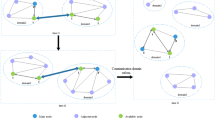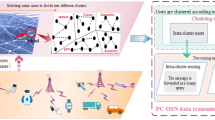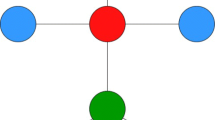Abstract
With the rapid popularization of mobile smart devices in the IoT and the 5G environment, nodes’ requirements for network response speed are constantly increasing. Edge computing uses edge servers to perform simple processing when data is transmitted, increasing the response speed of devices and reducing the pressure on network traffic. However, the random movement of many nodes in an opportunistic social network easily leads to dynamic changes in the network structure and unstable transmission links. Therefore, this research proposes a data transmission strategy based on node motion prediction in opportunistic social networks (MPDTS). Any node will be assigned to a different cluster depending on how likely it is to meet other nodes. Messages are forwarded within and between clusters using different judgment indicators. This method effectively combines the connection between nodes, the node’s activity level, and sports characteristics successfully reduces the waste of resources for invalid message delivery. Simultaneously, it improves the possibility of message forwarding to the target node. Comparative experiments with several methods show that the MPDTS method has more outstanding performance.











Similar content being viewed by others
Data Availability
Data used to support the findings of this study are currently under embargo while the research findings are commercialized.
References
Bouras, C., & Kalogeropoulos, R. (2022). Prediction mechanisms to improve 5G network node allocation and resource management. Wireless Personnel Communications. https://doi.org/10.1007/s11277-021-08957-4
Chithaluru, P., Tiwari, R., & Kumar, K. (2021). ARIOR: adaptive ranking based improved opportunistic routing in wireless sensor networks. Wireless Personal Communications. https://doi.org/10.1007/s11277-020-07709-0
Rajesh, L., & Mohan, H. S. (2022). Adaptive group teaching based clustering and data aggregation with routing in wireless sensor network. Wireless Personal Communications. https://doi.org/10.1007/s11277-021-08971-6
Li, H., Ota, K., & Dong, M. (2018). ECCN: orchestration of edge-centric computing and content-centric networking in the 5G radio access network. IEEE Wireless Communications. https://doi.org/10.1109/MWC.2018.1700315
Chen, Z., & Zhao, M. (2019). Information cache management and data transmission algorithm in opportunistic social networks. Wireless networks. https://doi.org/10.1007/s11276-018-1691-6
Gou, F., Wu J., (2022). "Triad link prediction method based on the evolutionary analysis with IoT in opportunistic social networks ", Computer Communications. 12th Oct, 181C (2022) pp. 143–155. DOI: https://doi.org/10.1016/j.comcom.2021.10.009.
Kayastha, N., Niyato, D., Wang, P., & Hossain, E. (2011). Applications, architectures, and protocol design issues for mobile social networks: a survey. Proceedings of the IEEE, 99(12), 2130–2158. https://doi.org/10.1109/JPROC.2011.2169033
Gou, F., & Wu, J. (2022). Message transmission strategy based on recurrent neural network and attention mechanism in IoT system. Journal of Circuits, Systems and Computers. https://doi.org/10.1142/S0218126622501262
Wu, J., Qu, J., & Yu, G. (2020). Behavior prediction based on interest characteristic and node communication in opportunistic social networks. Peer-to-Peer Networking and Applications. https://doi.org/10.1007/s12083-020-01060-8
Jain, K., & Mohapatra, S. (2019). Taxonomy of edge computing: challenges, opportunities, and data reduction methods. In F. Al-Turjman (Ed.), Edge computing EAI/Springer innovations in communication and computing. Cham: Springer.
Yang, S., Zhou, Z., Xie, P., Xu, N., & Dai, Z. (2022). Intelligent segmentation medical assistance system for MRI images of osteosarcoma in developing countries. Computational and Mathematical Methods in Medicine. https://doi.org/10.1155/2022/7703583
Zhu, Y., Chevalier, K., Wang, N., Wang, X., Palacharla P., Ikeuchi, T. (2020). "Efficient mobile edge computing with different memory capacities for mobile internet of things," 2020 International conference on computing, networking and communications (ICNC), Big Island, HI, USA, 2020, pp. 826–832, doi: https://doi.org/10.1109/ICNC47757.2020.9049727
Tan, Y., et al. (2021). A staging auxiliary diagnosis model for non-small cell lung cancer based the on intelligent medical system. Computational and Mathematical Methods in Medicine. https://doi.org/10.1155/2020/6654946
Zhan, X., Long, H., Duan, X., & Kong, G. (2021). A convolutional neural network-based intelligent medical system with sensors for assistive diagnosis and decision-making in non-small cell lung cancer. Sensors, 23, 7996. https://doi.org/10.3390/s21237996
Alameddine, H. A., Sharafeddine, S., Sebbah, S., Ayoubi, S., & Assi, C. (2019). Dynamic task offloading and scheduling for low-latency IoT services in multi-access edge computing. IEEE Journal on Selected Areas in Communications, 37(3), 668–682. https://doi.org/10.1109/JSAC.2019.2894306
Zhigang, C. H. E. N., & Ming, Z. H. A. O. (2019). Weight distribution and community reconstitution based on communities communications in social opportunistic networks. Peer-to-Peer Networking and Applications., 12(1), 158–166. https://doi.org/10.1007/s12083-018-0649-x
Dhurandher, S. K., Singh, J., Woungang, I., Kumar, R., & Gupta, G. (2020). Message trust-based secure multipath routing protocol for opportunistic networks. International Journal of Communication System, 33, e4364. https://doi.org/10.1002/dac.4364
Syed Rabiya, M., & Ramar, R. (2020). Multiattribute-based routing for lifetime maximization in opportunistic mobile social networks. International Journal of Communication Systems. https://doi.org/10.1002/dac.4312
Shen, Y., Gou, F., & Dai, Z. (2022). Osteosarcoma MRI image-assisted segmentation system base on guided aggregated bilateral network. Mathematics, 10, 1090. https://doi.org/10.3390/math10071090
Wu, J., Gou, F., & Tian, X. (2022). Disease control and prevention in rare plants based on the dominant population selection method in opportunistic social networks. Computational Intelligence and Neuroscience. https://doi.org/10.1155/2022/1489988
Yuan, P., Pang, X., & Song, M. (2019). SSR: Using the social similarity to improve the data forwarding performance in mobile opportunistic networks. IEEE Access, 7, 44840–44850. https://doi.org/10.1109/ACCESS.2019.2908920
Ying, B., Xu, K., & Nayak, A. (2019). Fair and social-aware message forwarding method in opportunistic social networks. IEEE Communications Letters, 23(4), 720–723. https://doi.org/10.1109/LCOMM.2019.2900892
Wang, R., Wang, X., Hao, F., et al. (2018). Social identity–aware opportunistic routing in mobile social networks. Trans Emerging Tel Tech., 29, e3297. https://doi.org/10.1002/ett.3297
Wu, J., Chen, Z., & Zhao, M. (2020). Community recombination and duplication node traverse algorithm in opportunistic social networks. Peer-to-Peer Networking and Applications, 13, 940–947.
Huang, W., Ma, Z., Dai X., Xu, M., (2018). "Connectivity probability based spray and wait routing algorithm in mobile opportunistic networks," 2018 IEEE SmartWorld, Ubiquitous intelligence & computing, advanced & trusted computing, scalable computing & communications, cloud & big data computing, internet of people and smart city innovation (SmartWorld/SCALCOM/UIC/ATC/CBDCom/IOP/SCI), Guangzhou, 2018, pp. 1636-1642, doi: https://doi.org/10.1109/SmartWorld.2018.00280
Yang, W., & Luo, J. (2020). Effective date transmission and control base on social communication in social opportunistic complex networks. Complexity, 2020, 1–20.
Wu, J., Chen, Z., & Zhao, M. (2020). An efficient data packet iteration and transmission algorithm in opportunistic social networks. Journal of Ambient Intelligence and Humanized Computing., 11, 3141–3153. https://doi.org/10.1007/s12652-019-01480-2
Xiao, Y., & Wu, J. (2020). Data transmission and management based on node communication in opportunistic social networks. Symmetry., 12(8), 1288. https://doi.org/10.3390/sym12081288
Wu, J., Yin, S., Xiao, Y., & Yu, G. (2020). Effective data selection and management method based on dynamic regulation in opportunistic social networks. Electronics, 9, 1271. https://doi.org/10.3390/electronics9081271
Yin, S., & Genghua, Y. (2020). Low energy consumption routing algorithm based on message importance in opportunistic social networks. Peer-to-Peer Networking and Applications. https://doi.org/10.1007/s12083-021-01072-y
Jiang, W., Feng, G., & Qin, S. (2017). Optimal cooperative content caching and delivery policy for heterogeneous cellular networks. IEEE Transactions on Mobile Computing. https://doi.org/10.1109/TMC.2016.2597851
Xiaoli LI and Jia WU,"Node-oriented secure data transmission algorithm based on IoT system in social networks", IEEE Communications Letters, Volume 24, Issue 12, pp. 2898–2902. 2020. DOI:https://doi.org/10.1109/LCOMM.2020.3017889.
Saha, B. K., Misra, S., & Pal, S. (2017). SeeR: Simulated annealing-based routing in opportunistic mobile networks. IEEE Transactions on Mobile Computing. https://doi.org/10.1109/TMC.2017.2673842
Chen, K., & Shen, H. (2017). Face change: attaining neighbor node anonymity in mobile opportunistic social networks with fine-grained control. IEEE/ACM Trans Network, 25(2), 1176–1189. https://doi.org/10.1109/TNET.2016.2623521
Mukherjee, A., Goswami, P., Yang, L., et al. (2020). Deep neural network-based clustering technique for secure IIoT. Neural Computing and Applications, 32, 16109–16117. https://doi.org/10.1007/s00521-020-04763-4
Shanmugam, R., & Kaliaperumal, B. (2021). An energy-efficient clustering and cross-layer-based opportunistic routing protocol (CORP) for wireless sensor network. International Journal of Communication Systems. https://doi.org/10.1002/dac.4752
Kumaram, S., Srivastava, S., & Sharma, D. (2020). Neural network-based routing protocol for opportunistic networks with intelligent water drop optimization. International Journal of Communication Systems, 33, e4368. https://doi.org/10.1002/dac.4368
Deng, Y. (2021). Hybrid data transmission scheme based on source node centrality and community reconstruction in opportunistic social network. Peer-to-Peer Networking and Applications, 14, 3460–3472. https://doi.org/10.1007/s12083-021-01205-3
Xiong, W., & Zhou, X. (2021). A reputation value-based task-sharing strategy in opportunistic complex social networks. Complexity. https://doi.org/10.1155/2021/8554351
Priyanka, B. N., Jayaparvathy, R., & DivyaBharathi, D. (2022). Efficient and dynamic cluster head selection for improving network lifetime in WSN using whale optimization algorithm. Wireless Personal Communications. https://doi.org/10.1007/s11277-021-09192-7
Li, X., Qi, H., & Wu, J. (2022). Efficient path-sense transmission based on IoT system in opportunistic social networks. Peer-to-Peer Netw. Appl. https://doi.org/10.1007/s12083-021-01286-0
Xia, J. (2022). Information transmission mode and IoT community reconstruction based on node influence in opportunistic social networks. Peer-to-Peer Networking and Applications. https://doi.org/10.1007/s12083-022-01309-4
Yang, W., & Luo, J. (2021). Application of information transmission control strategy based on incremental community division in IoT platform. IEEE Sensors Journal. https://doi.org/10.1109/JSEN.2021.3102683
Luo, J., Wu, J., Wu, Y., (2021). An efficient data transmission strategy for edge-computing-based opportunistic social networks. NPC 2020: Network and Parallel Computing. Vol 12639. pp 323–335.2021. DOI: https://doi.org/10.1007/978-3-030-79478-1_28.
Tay, M., & Senturk, A. (2022). A new energy-aware cluster head selection algorithm for wireless sensor networks. Wireless Personal Communications. https://doi.org/10.1007/s11277-021-08990-3
Ayub, Q., & Rashid, S. (2021). Energy efficient inactive node detection based routing protocol for delay tolerant network. Wireless Personal Communications. https://doi.org/10.1007/s11277-020-07712-5
Raj, S., & Rajesh, R. (2022). Routing protocol for low power and lossy network using energy efficient priority based routing. Wireless Personal Communications. https://doi.org/10.1007/s11277-021-09185-6
Funding
This work was supported in The National Natural Science Foundation of China (61672540); Hunan Provincial Natural Science Foundation of China (2018JJ3299, 2018JJ3682).
Author information
Authors and Affiliations
Contributions
All authors designed this works.
Corresponding author
Ethics declarations
Conflict of interest
The authors declare that they have no conflict of interest.
Additional information
Publisher's Note
Springer Nature remains neutral with regard to jurisdictional claims in published maps and institutional affiliations.
Rights and permissions
About this article
Cite this article
Gou, F., Wu, J. Data Transmission Strategy Based on Node Motion Prediction IoT System in Opportunistic Social Networks. Wireless Pers Commun 126, 1751–1768 (2022). https://doi.org/10.1007/s11277-022-09820-w
Accepted:
Published:
Issue Date:
DOI: https://doi.org/10.1007/s11277-022-09820-w




